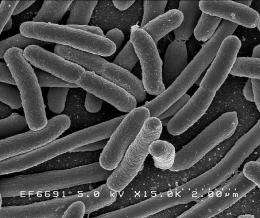Researchers identify most dangerous strains of often-deadly bacteria

A multi-disciplinary group of researchers at the University of Maryland School of Medicine (UM SOM) have for the first time determined the genetic makeup of various strains of E. coli, which every year kills hundreds of thousands of people around the world.
The paper, which appears in a recent issue of Nature Microbiology, analyzed the DNA of Enteropathogenic Escherichia coli (EPEC), which are the strains of the bacteria that cause diarrhea.
The scientists, led by David Rasko, PhD, Associate Professor of Microbiology and Immunology at the Institute for Genome Sciences (IGS) at UM SOM and Michael Donnenberg, MD, Professor of Medicine at UM SOM, identified certain strains that are typically much more lethal than others. The results will help researchers focus efforts to identify, treat and potentially control these more dangerous versions. This could lead to a better understanding of exactly how the bacteria causes damage, and eventually, more effective treatments that could significantly lower the death rate for diarrheal diseases, which are a leading cause of child mortality around the world. Each year diarrhea kills around 760,000 children under five. It is also is a leading cause of malnutrition in children under five years old. Globally, there are nearly 1.7 billion cases of diarrheal disease every year.
"These findings really help us map the associations between the bacteria and these illnesses in a new way. This kind of research would not have been possible a few years ago," says Dr. Rasko. "But with new advances, we can make these kinds of exciting discoveries." Rasko described the research as "genomic epidemiology," a new way of doing public health science that integrates the most cutting-edge technologies with an extensive knowledge of the pathogenic bacteria, both of which exist at the University of Maryland School of Medicine.
Dr. Rasko and his colleagues, including researchers in The Gambia, Mali, Kenya, Mozambique, India, Pakistan and Bangladesh, examined the genomes of 70 strains of E. coli, which were obtained from infected children enrolled in the Global Enterics Multi-Center study (GEMS). Some of the cases were associated with death, others where had symptoms but no death, and others were not associated with symptoms; as a result, the scientists had access to strains with a range of outcomes.
They analyzed the genetic differences between the strains and mapped them onto disease outcome. Then, they divided the strains into categories, based on genetic content and clinical outcome. They are not sure how the genetic variations may be linked to symptoms and outcomes, but the pattern provides a rich area for further research, Rasko said. He suspects that increased E. coli lethality is caused by a group of genes interacting rather than one or two genes.
"This research epitomizes what IGS is all about," says Claire M. Fraser, PhD, Director of IGS "We want to take genomics and use it in novel ways, ways that can be of practical use to clinicians around the world."
Over the past several years, IGS has increasingly taken a larger role in the study of the genetics of infectious disease. In 2014, it was awarded a five-year, $15.2 million grant from the National Institute of Allergy and Infectious Diseases to develop the Genome Center for Infectious Disease.
"This work by Dr. Rasko and his colleagues is on the cutting edge of how scientists can use data and genomics to get at difficult public health questions," says UM SOM Dean E. Albert Reece, MD, PhD, MBA, who is also Vice President of Medical Affairs at the University of Maryland and the John Z. and Akiko Bowers Distinguished Professor at UM SOM. "I am confident that they will continue to identify crucial leads in our fight to improve the lives of people around the world suffering from disease."
More information: Tracy H. Hazen et al. Genomic diversity of EPEC associated with clinical presentations of differing severity, Nature Microbiology (2016). DOI: 10.1038/nmicrobiol.2015.14
Journal information: Nature Microbiology
Provided by University of Maryland

















